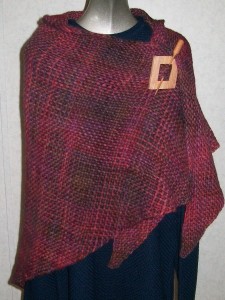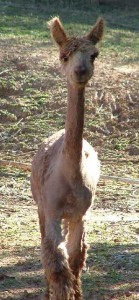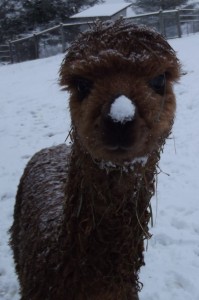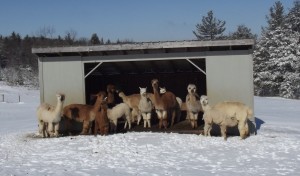Archive for February 2012
New Alpaca Coats in Stock
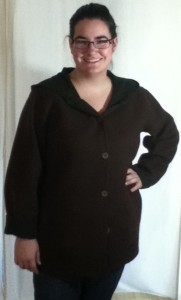 Our alpaca coats are beautiful and warm. The fineness of alpaca fiber makes these coats lightweight and comfortable to wear.
Our alpaca coats are beautiful and warm. The fineness of alpaca fiber makes these coats lightweight and comfortable to wear.
Reversible in two colors, our beautiful alpaca jackets have two pockets on each side and closes with 5 buttons up the front. A lovely hood will keep your head warm as well.
Available in 5 sizes, the alpaca coats come in a great variety of color combinations. We just received some new jackets in stock and now have 10 coats to choose from in a wide range of colors and sizes from Extra Small to Extra Large. Contact me if you are looking for a different size/color combination.
You can come by the farm store to try on these lovely alpaca coats, or order them online.
#gallery-1 { margin: auto; } #gallery-1 .gallery-item { float: left; margin-top: 10px; text-align: center; width: 50%; } #gallery-1 img { border: 2px solid #cfcfcf; } #gallery-1 .gallery-caption { margin-left: 0; } /* see gallery_shortcode() in wp-includes/media.php */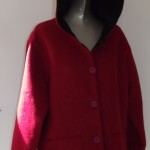 Extra Small Red/Black
Extra Small Red/Black
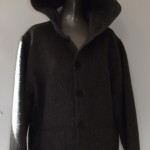 Extra Small Two Shades of Gray
Extra Small Two Shades of Gray
 Small Charcoal/Burgundy
Small Charcoal/Burgundy
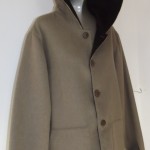 Small Taupe/Black
Small Taupe/Black
 Small Gray/Purple
Small Gray/Purple
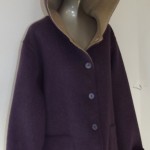 Medium Purple/Fawn
Medium Purple/Fawn
 Medium Two Shades of Blue
Medium Two Shades of Blue
 Large Black/Brown
Large Black/Brown
 Extra Large Tan/Brown
Extra Large Tan/Brown
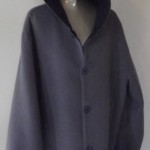 Extra Large Two Shades of Blue
Extra Large Two Shades of Blue



2012 Weaving Classes Scheduled
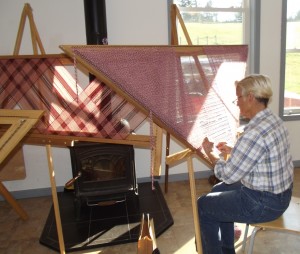 We have scheduled three of our popular Weaving an Alpaca Shawl on the Triangle Loom classes for 2012. We begin Friday evening, when we talk about design, pick out our yarns and begin weaving, then weave all day Saturday and Sunday (with breaks throughout the day to visit with the alpacas and enjoy great food). By the end of the weekend, you will go home with a beautiful alpaca shawl that you designed and wove.
We have scheduled three of our popular Weaving an Alpaca Shawl on the Triangle Loom classes for 2012. We begin Friday evening, when we talk about design, pick out our yarns and begin weaving, then weave all day Saturday and Sunday (with breaks throughout the day to visit with the alpacas and enjoy great food). By the end of the weekend, you will go home with a beautiful alpaca shawl that you designed and wove.
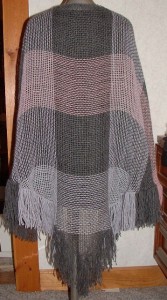 Classes are scheduled for June 29-July 1, August 17-19, and October 26-28. For more information, check out our class description. Visit our Facebook page to see pictures from our 2011 weaving classes .
Classes are scheduled for June 29-July 1, August 17-19, and October 26-28. For more information, check out our class description. Visit our Facebook page to see pictures from our 2011 weaving classes .

Shearing Alpacas
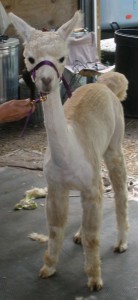 One of the most important things we do to care for our alpacas each year is to shear them. Our alpacas grow fiber between 2-6 inches long all over their bodies each year, which can total 3-11 pounds per alpaca. When the hot weather arrives, this beautiful, warm fiber can become incredibly hot for any alpaca not shorn, and can lead to heat stress and even death if it is not removed.
One of the most important things we do to care for our alpacas each year is to shear them. Our alpacas grow fiber between 2-6 inches long all over their bodies each year, which can total 3-11 pounds per alpaca. When the hot weather arrives, this beautiful, warm fiber can become incredibly hot for any alpaca not shorn, and can lead to heat stress and even death if it is not removed.
We shear our alpacas each year near the first of May. Our goal is to shear before it gets too hot, but late enough in the year the alpacas won’t get too cold without their coats.
 The shearing process takes about 15-30 minutes per alpaca. We restrain the alpacas so they do not move while we are shearing. The shears we use (the same used for sheep) are very safe, but could nick the alpacas if they move around during the shearing process.
The shearing process takes about 15-30 minutes per alpaca. We restrain the alpacas so they do not move while we are shearing. The shears we use (the same used for sheep) are very safe, but could nick the alpacas if they move around during the shearing process.
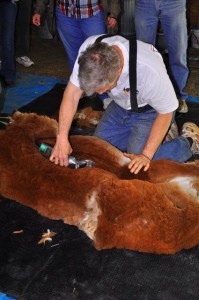 On shearing day, we gather the alpacas close to the barn. They are led into the shearing area on a halter and laid down on the shearing mat. We use the Pro-Tie system to hold their legs so they hold still during shearing, and someone always holds their head and talks with them as we shear. One side is shorn, following a very specific pattern to keep separate the coarser belly and leg fibers (thirds) from the blanket fiber (first or prime fiber) and neck fiber (seconds). The blanket fiber rolls off the alpaca as it is cut and can be pulled off in one or two pieces, depending on one’s shearing style. We shear one half, then turn the alpaca and shear the other side. Often toenails and teeth are trimmed at this time if necessary and annual shots for tetanus and rabies given.
On shearing day, we gather the alpacas close to the barn. They are led into the shearing area on a halter and laid down on the shearing mat. We use the Pro-Tie system to hold their legs so they hold still during shearing, and someone always holds their head and talks with them as we shear. One side is shorn, following a very specific pattern to keep separate the coarser belly and leg fibers (thirds) from the blanket fiber (first or prime fiber) and neck fiber (seconds). The blanket fiber rolls off the alpaca as it is cut and can be pulled off in one or two pieces, depending on one’s shearing style. We shear one half, then turn the alpaca and shear the other side. Often toenails and teeth are trimmed at this time if necessary and annual shots for tetanus and rabies given.
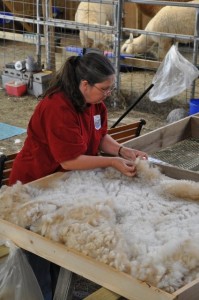 As the fiber comes off the alpaca, each of the three grades of fiber are placed on a separate sorting tray with a hardware cloth bottom. This open wire bottom allows dirt and debris to fall through, while the fiber is quickly sorted to pull out large pieces of hay and other pasture debris and sort out any hairy or short pieces of fiber called second cuts, which are caused if the shears take a second pass through an already shorn area. If left in with the longer fiber, these second cuts can cause slubs in the yarn when processed, leaving it lumpy and more likely to shed these short fibers over time. Often, there is not enough time to carefully sort the blanket fiber during the shearing day, so we roll it in a large piece of kraft paper to keep the shape intact and store it for later sorting. This is the fiber that the best yarn is made of, as well as the fiber that will be prepared for fleece shows and spinoffs, so it is important to handle the blanket with care. You can learn more about the sorting and yarn making process from an earlier post.
As the fiber comes off the alpaca, each of the three grades of fiber are placed on a separate sorting tray with a hardware cloth bottom. This open wire bottom allows dirt and debris to fall through, while the fiber is quickly sorted to pull out large pieces of hay and other pasture debris and sort out any hairy or short pieces of fiber called second cuts, which are caused if the shears take a second pass through an already shorn area. If left in with the longer fiber, these second cuts can cause slubs in the yarn when processed, leaving it lumpy and more likely to shed these short fibers over time. Often, there is not enough time to carefully sort the blanket fiber during the shearing day, so we roll it in a large piece of kraft paper to keep the shape intact and store it for later sorting. This is the fiber that the best yarn is made of, as well as the fiber that will be prepared for fleece shows and spinoffs, so it is important to handle the blanket with care. You can learn more about the sorting and yarn making process from an earlier post.
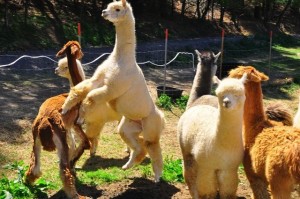 After the alpaca is shorn, we put their halter back on, release them from the mat, and walk them back into the pasture. The boys often will run around the pasture and seem to make fun of the first few shorn, with those who still have their fleeces showing off how much bigger they are. The girls are curious about other girls’ new haircuts, but after a few sniffs, usually go right back to eating. The alpacas themselves seem to be pleased with their new haircuts and the fresh feeling of giving up all that fiber. They are now ready to face the summer warmth and love to roll and sunbathe, leaving us to put last year’s fiber growth to good use, while they start growing next year’s crop.
After the alpaca is shorn, we put their halter back on, release them from the mat, and walk them back into the pasture. The boys often will run around the pasture and seem to make fun of the first few shorn, with those who still have their fleeces showing off how much bigger they are. The girls are curious about other girls’ new haircuts, but after a few sniffs, usually go right back to eating. The alpacas themselves seem to be pleased with their new haircuts and the fresh feeling of giving up all that fiber. They are now ready to face the summer warmth and love to roll and sunbathe, leaving us to put last year’s fiber growth to good use, while they start growing next year’s crop.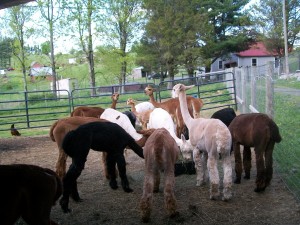
You can see more pictures from previous shearing days here and here.

Six Years of Alpaca Farming

Our farm when we first saw it, November 2005
We immediately started looking for a good farm for raising alpacas. We knew we wanted to be near the Blue Ridge Parkway, and when we found our farm right on the Parkway here at milepost 204, we knew it was perfect. Winter 2006 was as mild as the winter we are having this year, temperatures in January and the first half of February were in the 50’s. Looking at this great weather, we decided not to wait until spring but to come and get started preparing the farm for the alpacas to move in. The farm had not been lived on for at least 6 years before we moved here and there was only a small section of wood fence and an old barbed wire fence surrounding the property. Buildings consisted of our 100 year old (uninsulated) farmhouse, which is now the store, and a small storage shed near the store. .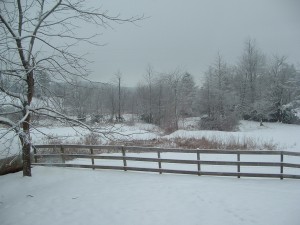 We arrived late on February 10, anxious to get started the next day. That night it snowed 6 inches. We woke to beautiful snow, which only increased our love of the beauty of our new farm. It also meant that getting the farm up and running just got harder. Our farmhouse/store is heated by gas, and we hadn’t had time to get the tank checked or filled yet. It receives its water from our springhouse, which not only had a broken pump, but was full of mud since the stream going out from the springhouse had been untended for years and had backed up. We did have electricity, though, and had a warm place to live since we had come to Virginia in our motorhome.
.
We arrived late on February 10, anxious to get started the next day. That night it snowed 6 inches. We woke to beautiful snow, which only increased our love of the beauty of our new farm. It also meant that getting the farm up and running just got harder. Our farmhouse/store is heated by gas, and we hadn’t had time to get the tank checked or filled yet. It receives its water from our springhouse, which not only had a broken pump, but was full of mud since the stream going out from the springhouse had been untended for years and had backed up. We did have electricity, though, and had a warm place to live since we had come to Virginia in our motorhome.
.
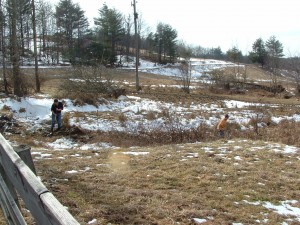
Cleaning out the stream
What followed was hard, but fun, work as we dug out the stream bed, cleaned in a house so cold the water froze as we mopped, and cleaned out the left behind debris in our one shed and around the farm. .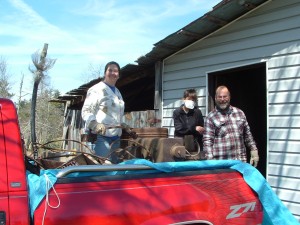
Cleaning out the shed
Over the next few weeks and months, the weather improved quickly. We had fencing put in for our first few pastures, built sheds for the alpacas, started work on the barn (big enough to fit the motorhome inside during the winter as it was home for the first couple years). .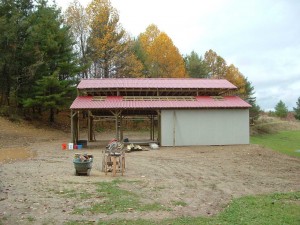
Barn in progress
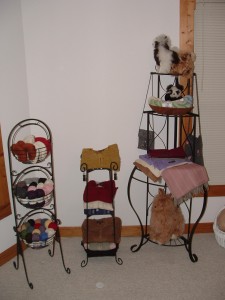
Our store once occupied just the first room of our farmhouse
Our first alpacas moved on to the farm in May of 2006 and we opened our store in June of that year. Throughout the year, we continued to move our alpacas onto the farm as we finished fencing in each new pasture and put up sheds. Our first cria, Sunrise Surprise was born on the farm in September and our last alpaca came home to the farm in December of 2006. .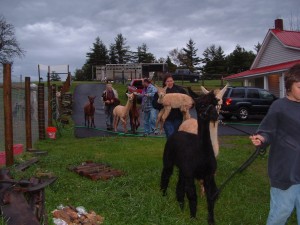
Moving in day for the girls during stormy weather
It has been a busy six years, full of wonderful experiences with the alpacas and all the great people we meet at the farm. Our farm now is home to over 40 alpacas, a three room store, a fiber art studio where we offer classes, and an online alpaca store. We never imagined that life would be this exciting when we first started raising alpacas, but we continue to look forward to new adventures every day.
Alpaca Slippers now in stock – all sizes
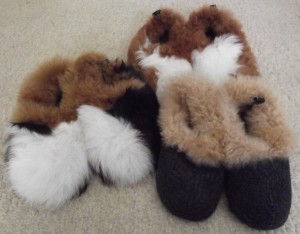
Reversible Slippers, wear them with fleece inside or outside
We have just got some new reversible alpaca slippers in stock. These incredibly warm and soft slippers can be worn with either the alpaca fleece or alpaca fabric on the inside. A padded insert sole provides extra cushion for your feet.
The slippers come in 5 sizes: Extra Small (Children’s Large; Ladies 3/4/5;) Small (Ladies 5/6/7; Mens 4/5/6); Medium (Ladies 7/8/9; Mens 6/7/8); Large (ladies 9/10/11, mens 8/9/10) and XL (ladies 10/11, mens 11/12).
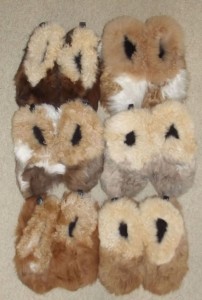
Each pair is unique
The slippers and the sole insert are both hand washable, though the slippers should be washed gently and not left to soak. After they are completely dry they can be brushed gently with a wire brush to fluff. The fleece side can also be freshened up when dry by brushing with a little baby powder and a wire brush.
These beautiful alpaca slippers are now in stock in all sizes. Visit our online store to see our selection, or come by the store and try on a pair.

New Pictures of our 2011 alpaca crias
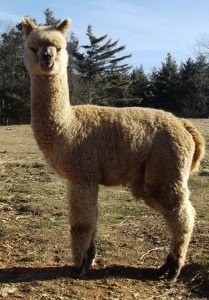
Becket
I have been updating pictures of our alpaca crias born last year. They grow so fast and have changed a lot in the past few months. You can see pictures of all of them on our Facebook page. You do not have to be a Facebook member to look at the pictures, though if you are, be sure to “Like” us to keep up on news and pictures from our alpaca farm.
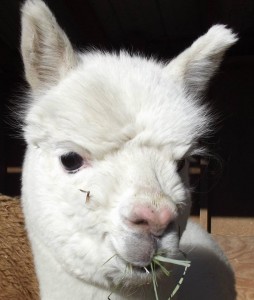
Angelica

Valentine’s Day Gift Ideas & Discount
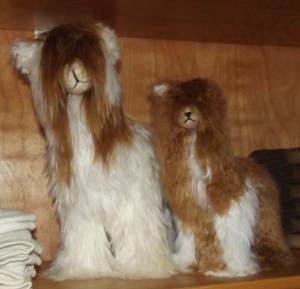 Valentine’s Day is fast approaching, and we wanted to let you know about the beautiful alpaca items we carry that are perfect for gifts or for treating yourself to something soft and warm.
Valentine’s Day is fast approaching, and we wanted to let you know about the beautiful alpaca items we carry that are perfect for gifts or for treating yourself to something soft and warm.
We have a wide range of new plush alpacas and teddy bears in the store. We also have a great selection of our classic scarves, reversible coats and vests in stock. We have something for everyone.
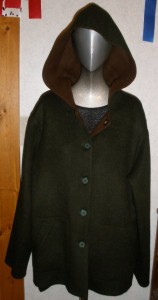 Visit our store in person or online to see our new items and items on sale. In addition, we are offering a 10% discount on any one item during the month of February. To redeem online, enter Valentine as the Promo code when you checkout.
Visit our store in person or online to see our new items and items on sale. In addition, we are offering a 10% discount on any one item during the month of February. To redeem online, enter Valentine as the Promo code when you checkout.
To redeem in the store, tell us you want to redeem your Valentine discount as you checkout. We are open Friday & Saturday from 10am-5pm or Sunday 1-5pm. Give us a call if you’d like to come by during the week. We look forward to seeing you.
If you are ordering for Valentine’s Day, we recommend you order by Friday, February 10 to allow enough time for your package to arrive by Priority Mail. The 10% discount offer expires February 29, 2012.

